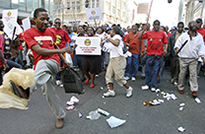As the economic centre of South Africa, the GCR has historically provided immense opportunity to its residents. Many more, however, have not befitted substantially from living in the region and face stark daily realities. The primary challenge for the city-region is to continue to promote investment but also to uplift impoverished and marginalised communities. This balance is not easily achieved but important inroads have been made.
Some citizens in Gauteng live a lifestyle that would not be out of place in any of the great cities of the world. City-regions often facilitate high quality and high-tech lifestyles as well as employment in globally competitive companies. They attract entrepreneurs, bright minds, and ambitious individuals. They offer exposure to art and culture, safety and security, and green and public spaces. The GCR does this for many.
However, city-regions can also be alienating in and of themselves. Cities and city-regions are often points of conflict and exclusion, as ‘the poor’ battle to find a toehold in the economy and broader society. Gauteng is no different, and has a post-apartheid spatial configuration to overcome. The new black middle class is able to afford to live in suburbia, which was formally the preserve of white residents only, but the poor are locked into the townships previously zoned for other race groups by apartheid, or in informal settlements wherever space can be found. Meagre incomes are spent on basic needs and on transport from the distant periphery to the region’s three economic centres where true opportunity remains.





